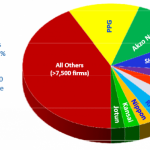Extreme volatility (Dow Jones 2% Days) continues being a major feature in the market; Tuesday of this week saw the Dow Jones close 2.17% above the previous day’s close. Yes, this was a big daily gain, but big daily percentage gains are events usually seen in bear markets. So, that’s the third day of extreme volatility in the past two weeks (see Mr. Bear’s Report Card below), and that isn’t normal, or bullish.
Of course that doesn’t mean that the market is on the cusp of a major crash in valuations. The Dow Jones closed the week only 5.61% away from making a new all-time high, and I wouldn’t be surprised if sometime in the next month the Dow Jones finds itself once again rising into record territory. So, I take the current trend in rising volatility as the market’s way of telling us as we go forward, risks are increasing as the potential for profits decline.
So far we’ve seen only one NYSE Day of Extreme Market Breadth (NYSE 70% Day). If the market is entering a bear market, we’ll see more of those, both positive and negative in the weeks and months to come.
Next is Mr. Bear’s Report Card from October 2008, a time when Mr Bear was running amok on Wall Street. Of the twenty-five NYSE trading sessions seen below, the Dow Jones saw only seven days where it moved less than 2% from a previous day’s close. And note the two largest daily moves, October 13th and 28th, were double-digit percentage ADVANCES. In fact during the entire sub-prime bear market (the #2 deepest Dow Jones Bear Market since 1885), from October 2007 to March 2009 the Dow Jones never saw a double-digit percentage decline from a previous day’s close. The largest daily percentage decline occurred on October 15th, the -7.87% decline seen in the table below.
Next is the Dow Jones’ BEV chart, and as noted previously the Dow Jones closed the week down 5.61% from its last all-time high, within easy scoring position for another BEV Zero should the bulls decide to make a go of it.
I went back to January 1982 for this chart to point out that since 1982, the stock market has actually been one continuous bull market. That’s not to say that this bull market hasn’t seen its leadership change over the past four decades.
In the 1980’s the market was dominated by Leveraged Buyout Artists, as they were called at the time, private equity firms using junk bonds to finance their acquisitions in the market. The 1987 movie Wall Street starring Michael Douglas and Charlie Sheen has the flavor of the times in it – “greed is good.”
The 1990’s was the high-tech decade, a time where small high-tech companies, such as Apple and Microsoft came to dominate not only the stock market, but our vision of the future. Smoke stacks were out – microprocessors were in.
Then came the sub-prime mortgage bubble (2002-07). Though this bubble was actually a real estate bubble, it had an impact on Wall Street too, both the boom and the bust.
And lastly, the post March 2009 bubble where just about everything but the values of gold, silver and their mining shares have been inflated to obscene levels.
The BEV chart below has an interesting feature; each of the first three bubbles listed above was terminated by a major market decline in the Dow Jones. I placed a shaded box over these market declines, and it should be noted that each succeeding decline was deeper than the previous ones. This is only to be expected; as the higher one flies the farther one has to fall.
Our current market advance, the post March 2009 market has yet to see a significant market decline. But if this pattern of ever greater market declines holds, the next bear market could be a real whopper.
Is that likely? Looking at the Frequency Distribution Table in the BEV chart above; I think it is. The first two rows in the table;
0% = Daily New All-Time Highs
-0.0001% = Daily Closes just short of an all-time high down to -4.999% from one.
The frequency distribution table’s top two rows include all the Dow Jones daily closings from January 1982 to today that were new all-time highs or within 5% of making one. Incredibly, 49.84% of the 9,281 daily closes during these four decades were within 5% of their last all-time highs.


















Leave A Comment